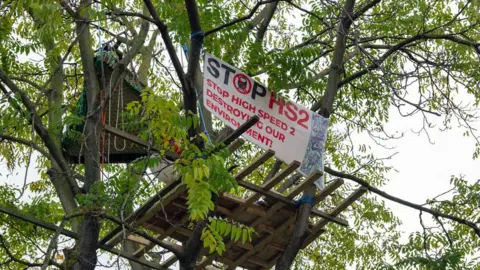HS2 protesters dig tunnel to thwart Euston eviction
People campaigning against the HS2 rail project have dug a tunnel near Euston station, in a bid to prevent their eviction from a protest camp.
In September, members of HS2 Rebellion set up a Tree Protection Camp in Euston Square Gardens in central London to protest against the £106bn scheme.
They claim the tunnel is 100ft (30m) long and has taken two months to dig.
Activists say the tunnel - codenamed "Kelvin" - is their "best defence" against being evicted.
One protester, identified only as Blue, told the BBC: "It is all very dangerous and life-threatening but it is all worth it. This is the only way I can effect change, I would sacrifice everything for the climate ecological emergency to not be happening."
The 18-year-old added: "We want to be as safe as possible. It is not about us martyring ourselves, it is about delaying and stopping HS2."
 Getty Images
Getty ImagesA spokeswoman for HS2 said tunnel protests were "costly to the taxpayer".
She added: "These are a danger to the safety of the protesters, HS2 staff, High Court enforcement officers and the general public, as well as putting unnecessary strain on the emergency services during the pandemic.
"Safety is our first priority when taking possession of land and removing illegal encampments."
British Transport Police said it was aware of the tunnel but it was a matter for the Met Police, which said no complaint yet had been made.
HS2 is set to link London, Birmingham, Manchester and Leeds. It is hoped the 20-year project will reduce rail passenger overcrowding and help to rebalance the UK's economy.
The campaign group alleges HS2 is the "most expensive, wasteful and destructive project in UK history" and that it is "set to destroy or irreparably damage 108 ancient woodlands and 693 wildlife sites".
However, HS2 bosses have said seven million trees will be planted during phase one of the project and that much ancient woodland will "remain intact".

Transport Secretary Grant Shapps told MPs in September that the first phase of the high-speed rail link between London and Birmingham would not open until 2028 at the earliest.
The second phase, to Manchester and Leeds, was due to open in 2032-33 but that has been pushed back to 2035-40.
Network Rail, which owns the land, has been approached for a comment about the tunnel.


Analysis
By BBC London's transport correspondent Tom Edwards
Tunnelling as a form of environmental protest has a long history in the UK.
In the 1990s it was one of the ways that pushed environmental concerns into the headlines and changed perceptions.
In one of the environmental protesters' tunnelling guides, written by "Disco Dave", it says:
"In the world of NVDA (non-violent direct action) there are few defence tactics that can compare with the protest tunnel. Dangerous, laborious and time consuming, tunnelling is the ultimate and desperate tactic of desperate people in desperate times."
The first protest tunnel goes back to the M11 and 1993 but they only really developed during the Newbury Bypass protests in 1996.
Protest tunnels against the A30 in Devon and Manchester Airport's second runway then followed.
Not only did they make household names of environmental campaigners like "Swampy" but they arguably changed transport policy - road-building reduced massively.
We have seen tunnels more recently in 2017 in Coldharbour in Surrey in a protest against fracking so it's not a massive surprise we are seeing tunnels again.
Tunnelling in particular as a direct action slows down developers and it is expensive to dig out protesters safely.
Disco Dave wrote: "That ultimately is the purpose of tunnels and tree houses. To act as a deterrent warning the authorities that should they decide to evict, then it will hurt them where for them it hurts most - in the pocket."
What will be interesting is if these tunnels have the same impact on HS2 as they did on the road-building programme of the late 1990s.
Will it reframe HS2 so it will be seen in the same way as fracking or road building? Or can the argument still be made that it is a low-carbon form of travel even though it does cause some destruction of habitat?